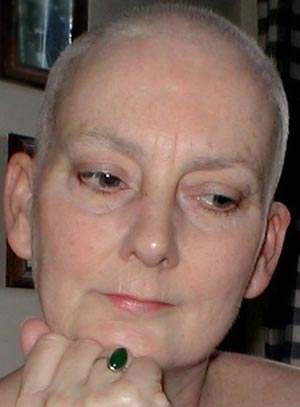Baldness (alopecia)
Baldness (alopecia) is the partial or complete loss of hair
With age, in men and women will decrease the density of hair. Men have a particular pattern of baldness associated with the hormone testosterone. If a man does not produce testosterone (because of genetic abnormalities or castration), then he will have no such pattern baldness. Women also have a special pattern baldness.
Alopecia occurs most often on the scalp, usually occurs gradually and may lose all scalp hair (alopecia totalis) or just the patches on the scalp. About 25 percent of men begin to bald by the age of 30 years and about two-thirds of men to be bald by the age of 60 years. The average scalp contains 100,000 strands of hair and every day, an average of 100 strands of hair missing from the head. Each strand of hair was 4.5 years, with growth of about 1 cm / month. Usually in year 5 and the hair will fall out within 6 months will be replaced by new hair.
Cause
- Descendants
- Aging
- Changes in hormone
- Fever
- The state of local skin
- Systemic Diseases
- Certain medications,such as those used to treat cancer / excessive vitamin A
- Use a shampoo and hair dryer excessive
- Emotional stress or physical stress
- Anxious behavior (habit of pulling hair or scratching of the scalp)
- Burns
- Radiation therapy
- Tinea capitis
- Trichotillomania.
Symptom
Male Pattern Baldness
Male pattern baldness is a particular pattern of baldness in men, which is caused by hormonal changes and heredity. Baldness occurs due to the shrinking hair follicles that produce hair is shorter and smoother. The end result of this situation is the root hairs are very small, with no hair.
Male pattern baldness begins at the hairline; in stages, the hairline down to form the letter M. Hair becomes smoother and does not grow along before. The hair on the crown also begins to thin and eventually the upper end of the M-shaped hairline meets the thinned crown which, forming a horseshoe-like baldness.
Female Pattern Baldness
Female pattern baldness is the loss of hair in women due to hormonal changes, aging and hereditary factors. Baldness occurs due to the failure of new hair growth. The cause of the failure is not completely understood, but allegedly related to hereditary factors, aging and androgen hormone levels. Different patterns of baldness in women with baldness in men. The hair on the hairline (forehead) remain, while the hair on the head of the other thin.
Baldness in women can also be caused by:
- Temporary hair loss (telogen effluvium)
- Damage caused by styling hair, curling hair or withdrawal
- Alopecia areata
- Drugs
- Certain skin diseases.
Alopecia Toksika
Alopecia or alopecia toksika poisoning can occur due to: - Severe disease accompanied by high fever.
- Excessive doses of some drugs (especially thallium, vitamin A and retinoids)
- The cancer drug
- The thyroid gland or pituitary gland is less active
- Pregnancy.
Hair loss can occur for 3-4 months after illness or other circumstances. Loss is usually temporary and hair will grow back.
Alopecia Areata
Alopecia areata is a condition in which sudden hair loss occurs in certain areas, usually on the scalp or beard. Alopecia universalis occurs at the loss of all body hair, while alopecia totalis in total baldness occurs on the scalp hair.
Trichotillomania
Trichotillomania is hair loss as a result of strong encouragement for the hair pulling. Hair loss can form a round or scattered patches on the scalp. Trichotillomania is a compulsive behavior, which may stem from the presence of emotional stress or physical stress.
Alopecia caused by scar tissue
Baldness occurs in areas of scar tissue. Scar tissue may be derived from burns, severe injury or radiation therapy.
Other causes of scarring alopecia due is:
- Lupus erythematosus
- Lichen planus
- Bacterial or fungal infections that are settled
- Sarcoidosis
- Tuberculosis
- Skin cancer.
Diagnosis
Determine the type of baldness is simply through the observation is sometimes difficult, because skin biopsy was performed to help establish the diagnosis. With biopsy can be known from the state of the hair root so that it can be determined the cause of baldness.
Treatment
Hair loss due to disease, radiation therapy or drug use, requiring no special treatment. If the disease improves or if treatment is stopped, the hair will grow back normally. During the hair is still in growth, the patient can use a wig, hat or other head covering.
Prevention
The following tips can help maintain healthy hair and minimizes hair loss:
A. Eat foods that are nutritionally balanced.
2. Handle your hair gently. If possible, let your hair dry naturally.
3. Avoid tight hairstyles such as braids, a bun or ponytail.
4. Avoid twisting, rubbing or pulling your hair.
5. Check with hair care expert on hair styles or techniques that can help reduce the effects of balding.
6. Drug minoxidil encourage new hair growth and prevent further hair loss in some people. Hair growth in other OTC products are not shown to have benefits.
" Baldness (alopecia) is the partial or complete loss of hair "


















Tidak ada komentar:
Posting Komentar